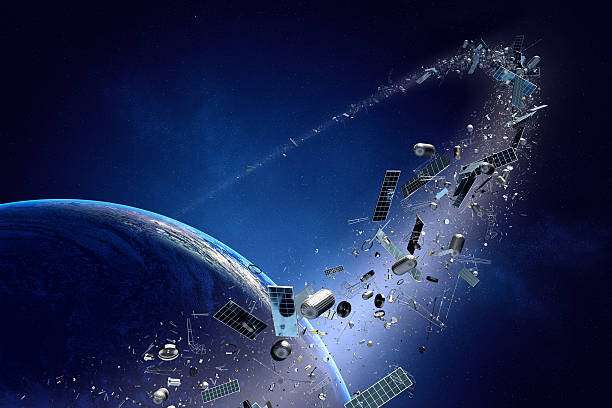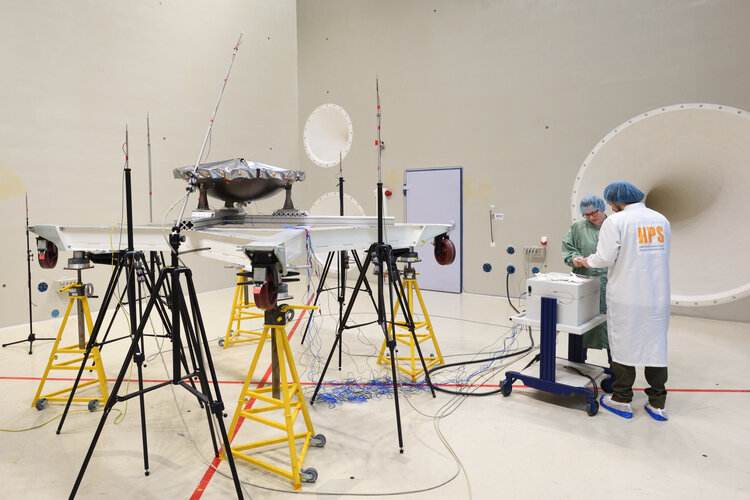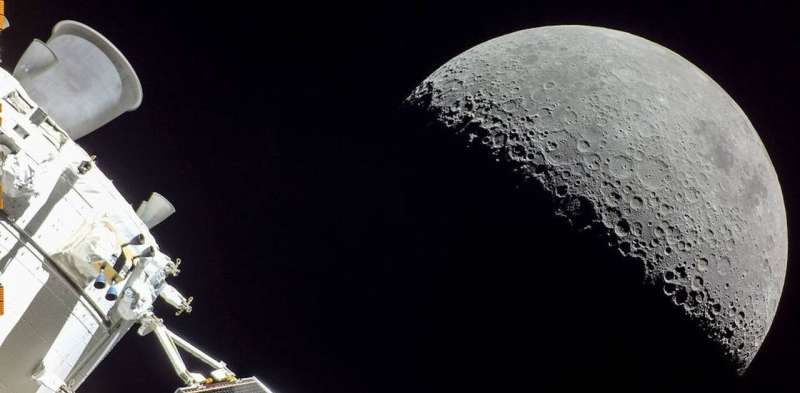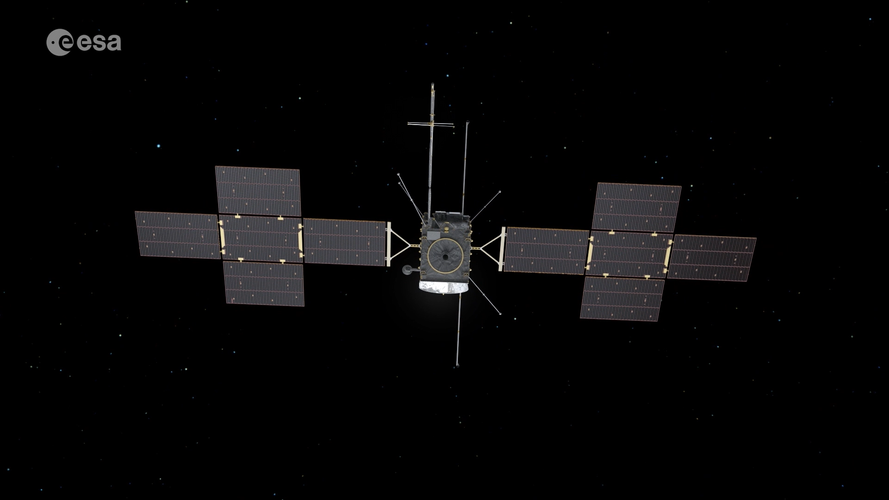A Russian satellite has broken into pieces, littering debris in space
Thursday, 09 February 2023 18:47
A Russian KOSMOS 2499 satellite broke up last month—for a second time—according to the Space Force's 18th Space Defense Squadron. In a recent tweet, the Space Force said they are currently tracking 85 individual pieces of debris at an altitude of 1,169 km (726 miles). The breakup occurred on January 4, 2023, but the reason for the disintegration remains unknown.
At this high altitude, it will take decades for the debris to deorbit and burn up in the Earth's atmosphere. The debris is located in an increasingly busy region in Earth's orbit.
#18SDS has confirmed the breakup of COSMOS 2499 (#39765, 2014-028E)—occurred Jan 4, 2023 at appx 0357 UTC. Tracking 85 associated pieces at est 1169 km altitude—analysis ongoing. #spacedebris#space@SpaceTrackOrg@US_SpaceCom@ussfspoc
— 18th Space Defense Squadron (@18thSDS) February 7, 2023
But this is actually the second breakup event of Kosmos 2499.
Sound test of Hera asteroid mission antenna
Thursday, 09 February 2023 17:35 Image:
Sound test of Hera asteroid mission antenna
Image:
Sound test of Hera asteroid mission antenna Artificial intelligence aiding the space business across the board
Thursday, 09 February 2023 15:55
Space companies are finding new ways to exploit artificial intelligence for commercial and national security operations, executives said Feb.
NanoAvionics expands production capacity for constellation transformation
Thursday, 09 February 2023 15:06
Lithuania-based NanoAvionics said it has doubled its small satellite production space to meet the needs of constellation operators.
More lunar missions means more space junk around the Moon—two astronomers are building a catalog to track the trash
Thursday, 09 February 2023 14:54
Scientists and government agencies have been worried about the space junk surrounding Earth for decades. But humanity's starry ambitions are farther reaching than the space just around Earth. Ever since the 1960s with the launch of the Apollo program and the emergence of the space race between the U.S. and Soviet Union, people have been leaving trash around the moon, too.
Today, experts estimate that there are a few dozen pieces of space junk like spent rocket bodies, defunct satellites and mission-related debris orbiting in cislunar space—the space between Earth and the moon and the area around the moon. While this isn't yet a large amount of junk, astronomers have very little information about where these pieces of space debris are, let alone what they are and how they got there.
Juice’s odyssey of exploration
Thursday, 09 February 2023 13:25 Video:
00:03:21
Three-minute cinematic video trailer presenting ESA’s Jupiter Icy Moons Explorer (Juice) mission
Video:
00:03:21
Three-minute cinematic video trailer presenting ESA’s Jupiter Icy Moons Explorer (Juice) mission Galileo signal component tested for Internet of Things use
Thursday, 09 February 2023 10:45
One of Europe's Galileo satellites has been reconfigured to emit a new signal component optimised to serve low-end receiver devices and Internet of Things applications.
Space Daily retools to AI/ML centric Content Management System
Thursday, 09 February 2023 07:58 SpaceDaily.com, a pioneer in the field of technology and science news for over 25 years, has announced the launch of a new AI/ML-centric Content Management System (CMS) that will take its newsroom operations to the next level. Building upon decades of automation process development, this innovative platform represents the future of SpaceDaily.com, leveraging the latest Large Language Model (LLM) software technology to enhance its news editorial and production capabilities.
SpaceDaily.com, a pioneer in the field of technology and science news for over 25 years, has announced the launch of a new AI/ML-centric Content Management System (CMS) that will take its newsroom operations to the next level. Building upon decades of automation process development, this innovative platform represents the future of SpaceDaily.com, leveraging the latest Large Language Model (LLM) software technology to enhance its news editorial and production capabilities. SpaceX to test-fire all 33 Starship booster engines Thursday
Thursday, 09 February 2023 07:58 SpaceX will embark on a monumental step toward launching Starship on Thursday when it test-fires all 33 of its first-stage boosters.
President Gwynne Shotwell shared a modest goal for the day, stating that not blowing up the launch pad would be considered a success. She was a keynote speaker at the Federal Aviation Administration's Annual Commercial Space Transportation Conference in Wa
SpaceX will embark on a monumental step toward launching Starship on Thursday when it test-fires all 33 of its first-stage boosters.
President Gwynne Shotwell shared a modest goal for the day, stating that not blowing up the launch pad would be considered a success. She was a keynote speaker at the Federal Aviation Administration's Annual Commercial Space Transportation Conference in Wa Russia launches resupply ship to int'l space station
Thursday, 09 February 2023 07:58 Russia successfully launched a Soyuz rocket from Kazakhstan on Thursday with a final destination of the International Space Station where it will deliver some 3 tons of supplies on the weekend.
The three-stage Soyuz-2 rocket launched as scheduled at 1:15 a.m. EST from the Baikonur Cosmodrome.
It was late morning in Baikonur when liftoff occurred, and the rocket soared through sun
Russia successfully launched a Soyuz rocket from Kazakhstan on Thursday with a final destination of the International Space Station where it will deliver some 3 tons of supplies on the weekend.
The three-stage Soyuz-2 rocket launched as scheduled at 1:15 a.m. EST from the Baikonur Cosmodrome.
It was late morning in Baikonur when liftoff occurred, and the rocket soared through sun Vulcan: Rocket stacked for inaugural launch
Thursday, 09 February 2023 07:58 Embarking on a bold new era to broaden affordable access to space, the inaugural United Launch Alliance (ULA) Vulcan rocket now stands assembled at its Florida launch site for pre-flight testing.
ULA technicians successfully stacked the all-American rocket atop the Vulcan Launch Platform (VLP) in the Vertical Integration Facility (VIF) at Cape Canaveral Space Force Station in preparation f
Embarking on a bold new era to broaden affordable access to space, the inaugural United Launch Alliance (ULA) Vulcan rocket now stands assembled at its Florida launch site for pre-flight testing.
ULA technicians successfully stacked the all-American rocket atop the Vulcan Launch Platform (VLP) in the Vertical Integration Facility (VIF) at Cape Canaveral Space Force Station in preparation f Climate: Could moon dust keep Earth cool?
Thursday, 09 February 2023 07:58 Whether out-of-the-box thinking or a sign of desperation, scientists on Wednesday proposed the regular transport of moon dust to a gravity point between Earth and Sun to temper the ravages of global warming.
Ideas for filtering solar radiation to keep Earth from overheating have been kicking around for decades, ranging from giant space-based screens to churning out reflective white clouds.
Whether out-of-the-box thinking or a sign of desperation, scientists on Wednesday proposed the regular transport of moon dust to a gravity point between Earth and Sun to temper the ravages of global warming.
Ideas for filtering solar radiation to keep Earth from overheating have been kicking around for decades, ranging from giant space-based screens to churning out reflective white clouds. NASA's Curiosity finds surprise clues to Mars' watery past
Thursday, 09 February 2023 07:58 When NASA's Curiosity rover arrived at the "sulfate-bearing unit" last fall, scientists thought they'd seen the last evidence that lakes once covered this region of Mars. That's because the rock layers here formed in drier settings than regions explored earlier in the mission. The area's sulfates - salty minerals - are thought to have been left behind when water was drying to a trickle.
So
When NASA's Curiosity rover arrived at the "sulfate-bearing unit" last fall, scientists thought they'd seen the last evidence that lakes once covered this region of Mars. That's because the rock layers here formed in drier settings than regions explored earlier in the mission. The area's sulfates - salty minerals - are thought to have been left behind when water was drying to a trickle.
So A new ring system discovered in our Solar System
Thursday, 09 February 2023 07:58 Scientists have discovered a new ring system around a dwarf planet on the edge of the Solar System. The ring system orbits much further out than is typical for other ring systems, calling into question current theories of how ring systems are formed.
The ring system is around a dwarf planet, named Quaoar, which is approximately half the size of Pluto and orbits the Sun beyond Neptune.
Scientists have discovered a new ring system around a dwarf planet on the edge of the Solar System. The ring system orbits much further out than is typical for other ring systems, calling into question current theories of how ring systems are formed.
The ring system is around a dwarf planet, named Quaoar, which is approximately half the size of Pluto and orbits the Sun beyond Neptune. Rocket Lab increases space systems offerings with new products for small satellites
Thursday, 09 February 2023 07:58 Rocket Lab USA, Inc. (Nasdaq: RKLB) has released two new high-performance space systems products designed to increase the availability of essential satellite components to the global small satellite market.
Bolstering the Company's existing line of proven satellite components, the new Rocket Lab products include the Frontier-X software defined radio designed to provide high speed data for
Rocket Lab USA, Inc. (Nasdaq: RKLB) has released two new high-performance space systems products designed to increase the availability of essential satellite components to the global small satellite market.
Bolstering the Company's existing line of proven satellite components, the new Rocket Lab products include the Frontier-X software defined radio designed to provide high speed data for 
